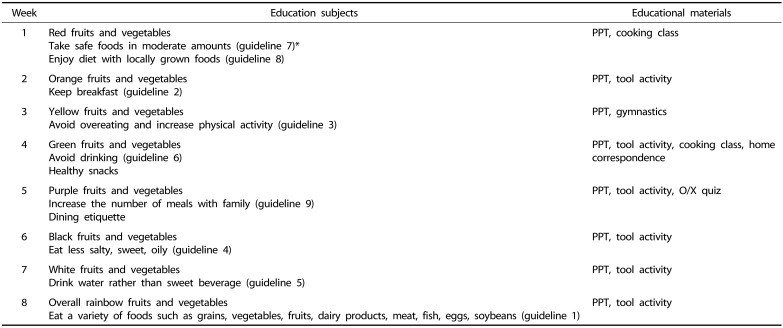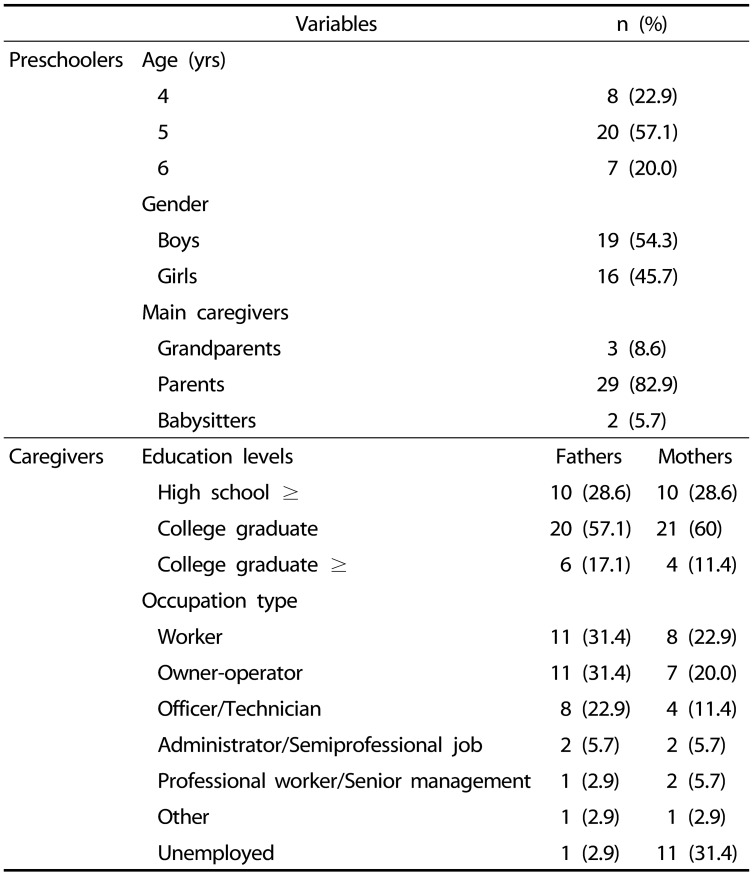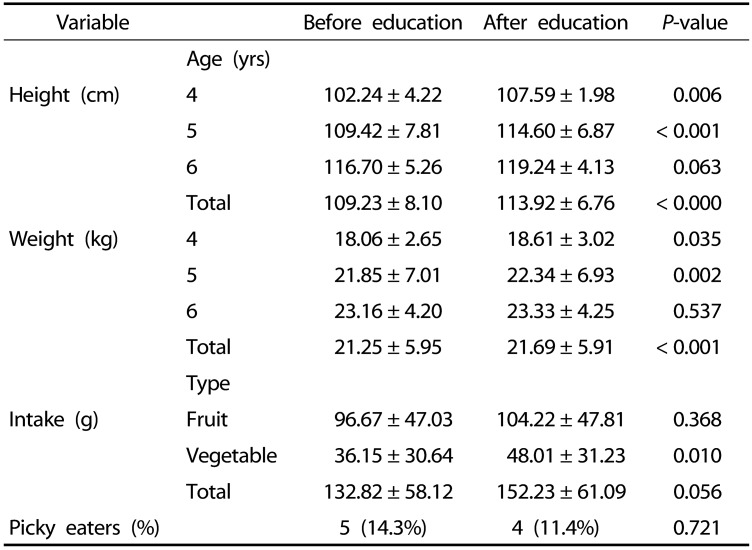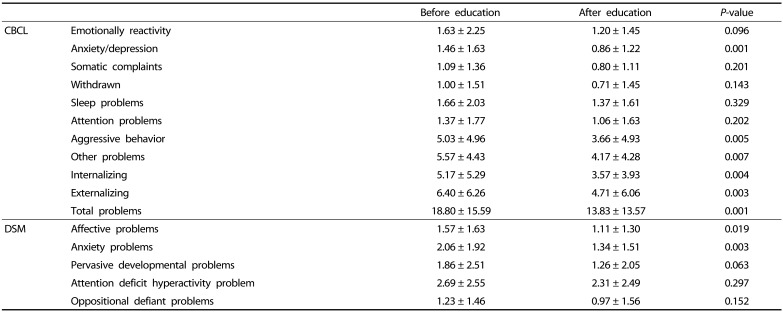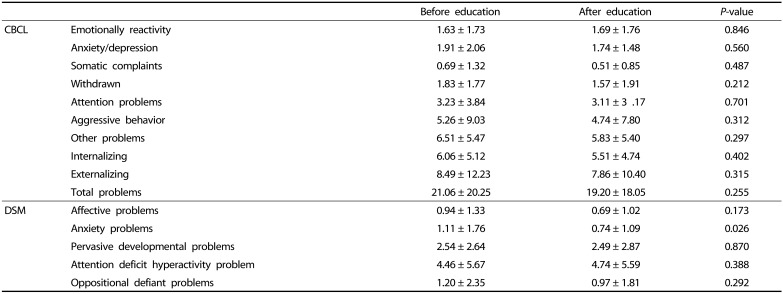Abstract
BACKGROUND/OBJECTIVES
Although a lot of effort has been put into increasing fruit and vegetable intakes in preschool children, vegetable intake in this group is still low. This study investigated whether nutrition education focusing on fruit and vegetable intakes can affect preschoolers' fruit and vegetable intakes as well as their behavioral outcomes.
SUBJECTS/METHODS
Thirty-five preschoolers (54.3% boys, n = 19) aged 4–6 years residing in Seoul underwent weekly nutrition education intervention (8 sessions) between May and July 2016. Intakes of fruits and vegetables were measured during pre and post-intervention. At snack time, fresh fruit (150 g) and vegetable (120 g) snacks were distributed to each child by teachers. The remaining portions of the snacks were weighed and recorded for each child. Behavioral outcomes were measured by applying Child behavior checklist 1.5–5 and the Diagnostic and statistical manual of mental disorders.
RESULTS
During post intervention, vegetable intake increased from 36.15 ± 30.64 g to 48.01 ± 31.23 g (P = 0.010). Among the emotional and behavioral problems measured by parents, levels of total problems (P = 0.001), internalizing (P = 0.004), externalizing (P = 0.003), anxiety and depression (P = 0.001), and aggressive behavior (P = 0.005) decreased. Anxiety (P = 0.026) score, as measured by teachers, also decreased.
CONCLUSIONS
Nutrition education of preschoolers regarding the intakes of fruits and vegetables had a positive effect on preschoolers' vegetable intake as well as on their emotional and behavioral outcomes. A long-term, large-scale study with a broader study design is warranted to further investigate the role of fruit and vegetable intake in cognitive development and behavior of preschoolers.
Keywords: Fruit, vegetable, behavior, child, education, emotions
INTRODUCTION
Growth and development are steadily occurring in preschool-aged children [1]. At this young age, balanced eating habits are important, because such habits can affect the children throughout the rest of their lives [1]. Although diets that have high levels of fruits and vegetables are universally encouraged for their health-promoting properties, preschoolers are less likely to choose vegetables due to a lack of familiarity and experience or to preferences for other foods [2].
Children's willingness to try new or healthy foods are affected by environmental factors such as those related to family, peers, community, and society, including the child's experiences at childcare facilities [3]. Intervention within the home environment including parental fruit and vegetable consumption patterns, the number of times parents give their children fruits and vegetables, and an increased availability and accessibility of fruits and vegetables were reported to be effective with home-based interventions accounting for about 48% of the variance in preschooler's fruit and vegetable scores [4]. Additionally, interventions at childcare facilities can provide nutrition education to preschoolers, parents, and teachers regarding healthy eating and the influence of increasing fruit and vegetable intakes in preschoolers [5,6].
The beneficial effects of eating fruits and vegetables on mental health have been widely reported in children [7,8], adolescents [8,9], and adults [10], although the measures used to determine fruit and vegetable consumption, as well as mental health status, have varied across studies. To the best of our knowledge, there are only two reports that provide information on preschoolers' fruit and vegetable consumption and their emotional and behavioral development, as measured by applying the Child behavior checklist (CBCL) 1.5–5 [11,12]. One populationbased study of US preschoolers compared development and behavioral outcomes between “picky” eaters and “non-picky” eaters and reported negative outcomes in picky eaters in all study categories [11]. In addition, a prospective cohort study has found that persistent picky eating was associated with pervasive developmental problems but was not associated with other behavioral problems [12]. However, those two studies presented somewhat inconsistent results, and no intervention-based study has been undertaken to examine the association between fruit and vegetable intakes and emotional and behavioral outcomes in preschoolers. Therefore, in this study, we investigated the association between the provision of nutritional education that promoted fruit and vegetable consumption and emotional and behavioral outcomes in preschoolers.
SUBJECTS AND METHODS
Study subjects
The study was approved by the Sangmyung University Institutional bioethics review board (approval number: BE 2016-11). Informed consents were obtained from the children's parents as well as from the teachers at the daycare centers. A total of 58 preschoolers from three daycare centers in Seoul were expected to participate, but only 41 of those participated in the study because several parents did not provide informed consent. A total of 35 subjects were finally enrolled in the study after exclusion of a child who moved out of district (n = 1) and those who failed to participate in the pre- or post-interventions (n = 6). The average age of the preschool children participating in this study was 4.97 ± 0.67 years (data not shown).
Measurements
Demographic variables
The weight and height of each child were measured before and after the nutrition education intervention. Questionnaires for the children's caregivers included general items such as gender, age, parental education and occupation, family status, income level, and health status of the child.
Intakes of fruits and vegetables in subjects
Intakes of fruits and vegetables by each preschooler were measured at pre- (May 16 and 18, 2016) and post- (July 18 and 20, 2016) intervention, and the results were used to assess the effects of nutrition education on fruit and vegetable intakes and behaviors of preschoolers [5]. At snack time, fruit and vegetable snacks were distributed to each child by their teachers. The fruit snack for each child consisted of one cup of mixed fresh fruits (150 g; grapes, pineapples, plums, and mandarins). The vegetable snack for children consisted of one cup of mixed fresh vegetables (120 g; bell peppers, carrots, tomatoes, broccoli, and cucumbers). Teachers were instructed not to mention the snack and not to encourage the children to eat the snack. At the end of snack time, the remaining portions of the snacks were weighed and recorded for each child.
CBCL 1.5–5 / Diagnostic and statistical manual of mental disorders (DSM)-5
The Achenbach system of empirically based assessment (ASEBA) evaluates behavior for individuals of all ages, from early childhood to senescence. The CBCL 1.5–5, one of the behavioral tests within ASEBA, was developed for assessment of problem behaviors in infants, toddlers, and young children between the ages of 1.5 and 5 years, and it has been validated for use in the Korean population [13]. CBCL 1.5–5 is used to obtain information on eight empirically based syndromes: emotional reactivity, anxiety/depression, somatic complaints, withdrawn, sleep problems, attention problems, and aggressive behavior [11]. The DSM-5 includes five subscales that reflect the DSM diagnostic system: DSM affective problems, DSM anxiety problems, DSM pervasive developmental problems, DSM attention deficit hyperactivity problem, and DSM oppositional defiant problems [14]. “Picky” eating is defined by two items within the CBCL 1.5–5. Parents were asked to indicate whether their child “does not eat well” and “refuses to eat” on a 3-point scale (not at all/sometimes/often) [15]. Picky eaters were defined as children with a score of sometimes and/or often on both the “does not eat well” and “refuses to eat” questions (resulting picky score ≥ 4) [15].
Nutrition education
Weekly nutrition education was provided to the enrolled preschoolers once a week for 8 weeks from May to July in 2016. The intervention was designed to promote the intake of fruits and vegetables by the study subjects and was based on learning the colors of the rainbow as represented by the colors of fruits and vegetables, as well as on dietary guidelines published in 2016 by the Ministry of Health and Welfare, Ministry of Agriculture, Food and Rural Affairs, and Ministry of Food and Drug Safety [16] (Table 1). In the first week, the preschoolers were taught about red fruits and vegetables, as well as dietary guidelines 7 (“Take safe foods in moderate amounts”) and 8 (“Enjoy diet with locally grown foods”), and were prompted to make a healthy sandwich with vegetables. The second week's education was about orange fruits and vegetables and guideline 2 (“Keep breakfast”) along with participation in play activity related to how to prepare breakfast. In the third week's intervention, preschoolers were taught the yellow fruits and vegetables as well as dietary guideline 3 (“Avoid overeating and increase physical activity”) and a simple gymnastic activity. The fourth week's education was about green fruits and vegetables and guideline 6 (“Avoid drinking”). Since guideline 6 was not appropriate for preschoolers, they were taught about how to “eat healthy snacks” by participating in a yogurt-tower cooking class. The fifth week's education was about purple fruits and vegetables and guideline 9 (“Increase the number of meals with family”) and a related theme (“Dining etiquette”) including a play quiz and play activity of how to use chopsticks. The dietary guidelines 6 and 9 were provided via home correspondence for parents. In the sixth week's education intervention, preschoolers were taught about black fruits and vegetables as well as dietary guideline 4 (“Eat less salty, sweet, oily”), and they participated in a play activity related to finding healthy food. The seventh week's education was about white fruits and vegetables as well as dietary guideline 5 (“Drink water rather than sweet beverage”) and the intervention was accompanied by a fairy tale. The eight week's education was about all of the colors of foods and guideline 1 (“Eat a variety of foods such as grains, vegetables, fruits, dairy products, meat, fish, eggs, and soybeans”).
Table 1. Outline of the nutrition education program for preschool subjects.
PPT: microsoft power point
* Guidelines are described in [16].
Statistical analysis
Data were entered into Microsoft Excel and analyzed using SPSS Statistical Software version 21.0 (SPSS Inc., Chicago, IL, USA). Paired t-tests for continuous variables and chi-squared tests for categorical variables were used to examine the differences in the anthropometric, emotional and behavioral problems, and the vegetable and fruit intakes between pre- and post-intervention. Statistical significance was defined as a P-value < 0.05.
RESULTS
General characteristics of subjects
The mean age of the participants was 4.97 ± 0.67 years old (data not shown) and more than half of the enrolled preschoolers were boys (54.3%). Parents were the children's main caregivers (82.9%) with most of the parents being college graduates (Table 2). Approximately two-thirds of the children's fathers were workers or owner-operators and about a third of their mothers were unemployed.
Table 2. General characteristics of subjects and caregivers (n = 35).
Changes in anthropometrics, intakes of fruits and vegetables, and picky eaters
Compared to their pre-intervention heights, post-intervention heights of the preschoolers were significantly higher in the 4-year-old (102.24 ± 4.22 cm to 107.59 ± 1.98 cm, P = 0.006) and 5-year-old (109.42 ± 7.81 cm to 114.60 ± 6.87 cm, P < 0.001) children (Table 3). Similarly, post-intervention body weights were significantly increased in the 4-year-old (18.06 ± 2.65 kg to 18.61 ± 3.02 kg, P = 0.035) and 5-year-old (21.85 ± 7.01 kg to 22.34 ± 6.93 kg, P = 0.002) preschoolers. The intake of vegetables increased significantly from 36.15 ± 30.64 g pre-intervention to 48.01 ± 31.23 g post-intervention (P = 0.010). The number of picky eaters decreased from 5 (14.3%) to 4 (11.4%), but the change was not statistically significant (P = 0.721).
Table 3. Changes in preschoolers' anthropometrics and intakes of fruits and vegetables.
Changes in emotional and behavioral outcomes
The changes of emotional and behavioral problems before and after the nutrition education intervention were analyzed according to the two intervention sources: caregivers and teachers. The results related to education provided by caregivers showed that compared to pre-intervention scores, the post-intervention preschoolers' problem behavior (18.80 ± 15.59 to 13.83 ± 13.57, P = 0.001), internalization (5.17 ± 5.29 to 3.57 ± 3.93, P = 0.004), externalization (6.40 ± 6.26 to 4.71 ± 6.06, P = 0.003), anxiety/depression (1.46 ± 1.63 to 0.86 ± 1.22, P = 0.001), attack behavior (5.03 ± 4.96 to 3.66 ± 4.93, P = 0.005), other issues (5.57 ± 4.43 to 4.17 ± 4.28, P = 0.007), DSM emotional issues (1.57 ± 1.63 to 1.11 ± 1.30, P = 0.019), and DSM anxiety problem (2.0 6 ± 1.92 to 1.34 ± 1.51, P = 0.003) scores were significantly lowered (Table 4). In contrast, the results related to education provided by teachers showed that only the DSM anxiety problem (1.11 ± 1.76 to 0.74 ± 1.09, P = 0.026) score was significantly lowered post-intervention (Table 5).
Table 4. Changes in preschoolers' emotional and behavioral outcome scores as measured by caregivers (n = 35).
CBCL, child behavior checklist; DSM, diagnostic and statistical manual of mental disorders.
Table 5. Changes in preschoolers' emotional and behavioral outcomes as measured by teachers (n = 35).
CBCL, child behavior checklist; DSM, diagnostic and statistical manual of mental disorders.
DISCUSSION
The results showed that vegetable intake by preschoolers increased (36.15 ± 30.64 g to 48.01 ± 31.23 g) after they participated in an eight-session nutrition education intervention. When assessed by the preschoolers' caregivers, the emotional and behavioral problem scores for the preschoolers decreased for total problems, as well as for internalizing, externalizing, anxiety and depression, and aggressive behavior. Anxiety scores, as measured by their teachers, also decreased. The results indicate that learning to eat fruits and vegetables in preschoolers may increase their intakes of fruits and vegetable and may have a positive effect on their emotional and behavioral outcomes.
Those results are consistent with previously reported findings [5,11]. The beneficial effects of eating fruit and vegetables rich in micronutrients on mental health are known in children [5,7,8,11] and those benefits may be due to the combined effects of a wide range of vitamins, minerals, and antioxidants [17]. In a population-based, cross-sectional assessment of preschoolers, scores related to total problems, internalizing scales, externalizing scales, and other problems measured by CBCL as well as scores on depressive problems, anxiety problems, the autism spectrum and disruptive/opposite problems measured by the DSM-5 subscales were greater in picky eaters than in non-picky eaters [11]. A similar result was reported from the nutrition education intervention study “Color me healthy” that provided fun, interactive learning opportunities on healthful eating and physical activity in the US to 4- and 5-year-old children. The results of that study showed that preschoolers who experienced the ‘Color me healthy’ intervention increased their consumption of fruit snacks by approximately 20.8% and vegetable snacks by 33.1% [5], thus showing the positive effect of nutrition education on the consumption of fruits and vegetables. However, those two studies [5,11] with similar results to those in the present study had several differences in study design from that in our study. ‘Color me healthy’ [5] did not include emotional and behavioral outcomes, and it extended the follow-up measurement of fruit and vegetable intakes to 3 months. The population-based study [11] only had a cross-sectional measurement of emotional and behavioral outcomes and did not assess fruit and vegetable intakes. In addition, previous studies on the relationship between eating habits and behavior outcomes of preschoolers reported that preschoolers who hated vegetables exhibited high self-centeredness, aggressiveness, and high anxiety [18], whereas preschoolers with poor eating habits showed lower adaptability, stability, sociability, and higher self-esteem than those with good eating habits, although a direct comparison was not feasible due to a lack of measurement of fruit and vegetable intakes [19].
Nevertheless, another study has shown results incompatible with ours. The consumption of fruits and vegetables did not increase after a four-session education intervention in preschoolers in Korea even though nutrition education increased the nutrition knowledge and perceived benefits of eating fruits and vegetables [1]. In a longitudinal study in preschoolers less than 7 years of age, persistent picky eating was longitudinally associated with pervasive developmental problems at age 7 years when measured by teachers; although persistent picky eating and other picky eating characteristics were not associated with behavioral or emotional problems [12]. This inconsistency between study results may be due to differences in study designs [1,12], the difference in analytical power of a study with 3,748 preschool-aged participants [12], and differences in gender proportions [1]. Therefore, a direct comparison with our study is not possible.
Although the importance of fruits and vegetables has always been emphasized, results from previous studies [5,11] on the effects of fruit and vegetable intakes on preschoolers' emotional and behavioral outcomes are uncommon or have limitations. Therefore, the present study is expected to be used as a model for future research into determining the relationships between eating habits and emotional and behavioral outcomes in preschoolers. However, there are limitations to this study: The number of subjects is relatively small, and control and comparison groups were not included. To overcome the latter, the study design needs to include a control group against which outcomes from the experimental group can be compared in order to minimize biases and variability of factors that may affect intervention outcomes, as well as to determine whether behavioral changes can be attributed to a dietary intervention. The control and experimental conditions must be applied simultaneously to guarantee both groups experience the same conditions such as physical growth [20]. Without such controls, there is a possibility that changes in the intake of fruits and vegetables as well as in behavioral outcomes may due to the physical growth of children; although the pre-intervention consumptions of fruits and vegetables were not different among the tertiles of the total behavioral scores in the present study. In addition, long-term nutrition education is needed to increase the intake of fruits and vegetables and to improve the emotional and behavioral outcomes. The typical level of fruit and vegetable intakes at home were not measured in this study. Assessment of the consumption of fruits and vegetables both at home and at childcare facilities should be undertaken to measure the long-term effect of nutrition education. Moreover, causal relationships between eating habits and emotional and behavioral outcomes in preschoolers warrant investigation in follow-up studies with robust study designs and adequate statistical power. Further research, including well-designed randomized controlled trials, is needed to clarify the specific biological mechanisms of such relationships. Moreover, future studies investigating how eating fruits and vegetables affects mental health, via multiple pathways such as through enhanced blood flow to the brain [21] or alterations in and potential roles of gut microbiota [22,23], are needed.
Footnotes
This study was supported by the grant from National Research Foundation of Korea (2017R1A2B1011821).
CONFLICT OF INTEREST: The authors declare no potential conflicts of interests.
References
- 1.Oh SM, Yu YL, Choi HI, Kim KY. Implementation and evaluation of nutrition education programs focusing on increasing vegetables, fruits, and dairy foods consumption for preschool children. Korean J Community Nutr. 2012;17:517–529. [Google Scholar]
- 2.Lee AR, Yu YL, Kim HJ, Kim KA, Kim KY. Status of dietary life related knowledge, self-efficacy, food preference and dietary behavior of preschoolers in Kyunggi area. Korean J Community Nutr. 2016;21:274–283. [Google Scholar]
- 3.De Cosmi V, Scaglioni S, Agostoni C. Early taste experiences and later food choices. Nutrients. 2017;9:107. doi: 10.3390/nu9020107. [DOI] [PMC free article] [PubMed] [Google Scholar]
- 4.Wyse R, Campbell E, Nathan N, Wolfenden L. Associations between characteristics of the home food environment and fruit and vegetable intake in preschool children: a cross-sectional study. BMC Public Health. 2011;11:938. doi: 10.1186/1471-2458-11-938. [DOI] [PMC free article] [PubMed] [Google Scholar]
- 5.Witt KE, Dunn C. Increasing fruit and vegetable consumption among preschoolers: evaluation of color me healthy. J Nutr Educ Behav. 2012;44:107–113. doi: 10.1016/j.jneb.2011.01.002. [DOI] [PubMed] [Google Scholar]
- 6.Sweitzer SJ, Briley ME, Roberts-Gray C, Hoelscher DM, Harrist RB, Staskel DM, Almansour FD. Lunch is in the bag: increasing fruits, vegetables, and whole grains in sack lunches of preschool-aged children. J Am Diet Assoc. 2010;110:1058–1064. doi: 10.1016/j.jada.2010.04.010. [DOI] [PMC free article] [PubMed] [Google Scholar]
- 7.Banta JE, Khoie-Mayer RN, Somaiya CK, McKinney O, Segovia-Siapco G. Mental health and food consumption among California children 5–11 years of age. Nutr Health. 2013;22:237–253. doi: 10.1177/0260106015599511. [DOI] [PubMed] [Google Scholar]
- 8.Richard A, Rohrmann S, Vandeleur CL, Mohler-Kuo M, Eichholzer M. Associations between fruit and vegetable consumption and psychological distress: results from a population-based study. BMC Psychiatry. 2015;15:213. doi: 10.1186/s12888-015-0597-4. [DOI] [PMC free article] [PubMed] [Google Scholar]
- 9.Brookie KL, Best GI, Conner TS. Intake of raw fruits and vegetables is associated with better mental health than intake of processed fruits and vegetables. Front Psychol. 2018;9:487. doi: 10.3389/fpsyg.2018.00487. [DOI] [PMC free article] [PubMed] [Google Scholar]
- 10.O'Neil A, Quirk SE, Housden S, Brennan SL, Williams LJ, Pasco JA, Berk M, Jacka FN. Relationship between diet and mental health in children and adolescents: a systematic review. Am J Public Health. 2014;104:e31–e42. doi: 10.2105/AJPH.2014.302110. [DOI] [PMC free article] [PubMed] [Google Scholar]
- 11.Machado BC, Dias P, Lima VS, Campos J, Gonçalves S. Prevalence and correlates of picky eating in preschool-aged children: a population-based study. Eat Behav. 2016;22:16–21. doi: 10.1016/j.eatbeh.2016.03.035. [DOI] [PubMed] [Google Scholar]
- 12.Cardona Cano S, Hoek HW, van Hoeken D, de Barse LM, Jaddoe VW, Verhulst FC, Tiemeier H. Behavioral outcomes of picky eating in childhood: a prospective study in the general population. J Child Psychol Psychiatry. 2016;57:1239–1246. doi: 10.1111/jcpp.12530. [DOI] [PubMed] [Google Scholar]
- 13.Kim YA, Lee J, Moon SJ, Kim YJ, Oh KJ. Standardization study for the Korean version of the Child Behavior Checklist for ages 1.5–5. Korean J Clin Psychol. 2009;28:117–136. [Google Scholar]
- 14.Lee J, Kim YH, Oh KJ. Discriminant validity and clinical utility of the Korean version of the Child Behavior Checklist for ages 1.5–5. Korean J Clin Psychol. 2009;28:171–186. [Google Scholar]
- 15.Cardona Cano S, Tiemeier H, Van Hoeken D, Tharner A, Jaddoe VW, Hofman A, Verhulst FC, Hoek HW. Trajectories of picky eating during childhood: a general population study. Int J Eat Disord. 2015;48:570–579. doi: 10.1002/eat.22384. [DOI] [PubMed] [Google Scholar]
- 16.The Korean Nutrition Society; Ministry of Health and Welfare. Dietary Reference Intakes for Koreans 2015. Seoul: The Korean Nutrition Society; 2016. [Google Scholar]
- 17.Rucklidge JJ, Kaplan BJ. Broad-spectrum micronutrient formulas for the treatment of psychiatric symptoms: a systematic review. Expert Rev Neurother. 2013;13:49–73. doi: 10.1586/ern.12.143. [DOI] [PubMed] [Google Scholar]
- 18.Park HS, Ahn SH. Eating habits and social behavior in Korean preschool children. Korean J Nutr. 2003;36:298–305. [Google Scholar]
- 19.Son HJ, Song JE, Son KC. Horticultural activities using colorful food for the improvement of emotional intelligence and the reduction of unbalanced vegetable diet of young children. Korean J Hort Sci Technol. 2015;33:772–783. [Google Scholar]
- 20.Byrd-Bredbenner C, Wu F, Spaccarotella K, Quick V, Martin-Biggers J, Zhang Y. Systematic review of control groups in nutrition education intervention research. Int J Behav Nutr Phys Act. 2017;14:91. doi: 10.1186/s12966-017-0546-3. [DOI] [PMC free article] [PubMed] [Google Scholar]
- 21.Ghosh D, Scheepens A. Vascular action of polyphenols. Mol Nutr Food Res. 2009;53:322–331. doi: 10.1002/mnfr.200800182. [DOI] [PubMed] [Google Scholar]
- 22.Dash S, Clarke G, Berk M, Jacka FN. The gut microbiome and diet in psychiatry: focus on depression. Curr Opin Psychiatry. 2015;28:1–6. doi: 10.1097/YCO.0000000000000117. [DOI] [PubMed] [Google Scholar]
- 23.Cryan JF, Dinan TG. Mind-altering microorganisms: the impact of the gut microbiota on brain and behaviour. Nat Rev Neurosci. 2012;13:701–712. doi: 10.1038/nrn3346. [DOI] [PubMed] [Google Scholar]



